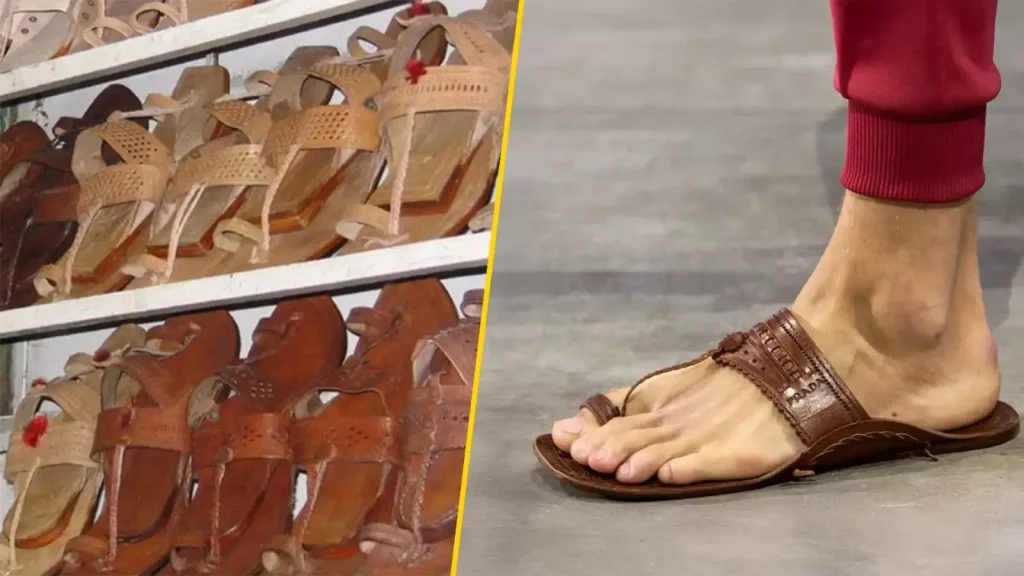Prada Kolhapuri Sandals have ignited a fiery debate in the fashion world, as they blend high fashion with traditional Indian craftsmanship. These sandals, inspired by the age-old Kolhapuri chappals, have been at the center of allegations of cultural appropriation. Known for their unique toe-loop design, Kolhapuri sandals are a hallmark of Indian artisanship, representing centuries of history and expertise. Despite their rich heritage, Prada’s failure to acknowledge this inspiration has sparked outrage and accusations of exploitation. The controversy not only highlights the ongoing struggle for recognition of traditional footwear but also raises critical questions about how modern brands engage with cultural artistry in the global marketplace.
The recent release of Prada’s leather sandals, reminiscent of traditional Kolhapuri footwear, brings forth a significant fashion controversy tied to cultural appropriation. As luxury brands increasingly draw from diverse cultural motifs, the line between inspiration and exploitation blurs, particularly concerning handcrafted models. Known as ‘chappals’, these durable and stylish sandals symbolize the skilled work of Indian artisans, yet many are questioning the ethics behind such adaptations. The discussion around Prada’s new collection underscores the deeper implications of traditional footwear being commercialized without due credit. As the spotlight shifts to these iconic Indian designs, it prompts a broader conversation about respect, recognition, and collaboration within the realm of global fashion.
The Heritage of Kolhapuri Sandals
Kolhapuri sandals, also known as Kolhapuri chappals, hold a significant place in Indian culture, particularly in Maharashtra where they originate. These handcrafted shoes are made by skilled artisans using traditional techniques that have been passed down for generations. They are characterized by their unique toe-loop design and are crafted from locally sourced buffalo hide, showcasing the craftsmanship and artistry that define Indian traditional footwear. Since the 12th century, these sandals have been a staple for many, representing both practicality and cultural identity in India.
Despite being affordable, with prices around $12, Kolhapuri sandals have come to symbolize a rich artistic legacy that reflects the heritage of Indian artisans. However, the recent controversy surrounding Prada’s Kolhapuri-inspired sandals has sparked a renewed conversation about the importance of acknowledging and compensating the artisans behind these traditional crafts. As global fashion brands incorporate ethnic designs without proper credit, it calls attention to the ongoing issues of cultural appropriation and the need for fair trade practices in the fashion industry.
Prada’s Cultural Appropriation Controversy
Prada’s revelation that their new leather sandals were inspired by traditional Kolhapuri sandals has drawn accusations of cultural appropriation from activists and artisans alike. The fashion house faced backlash for presenting their designs as innovative when, in fact, they closely mimicked the traditional Indian footwear. This controversy raises critical questions about the ethics of fashion, especially how luxury brands often strip cultural designs of their context and share them without due acknowledgment. Learning from this incident, it’s essential for global fashion houses to engage in meaningful dialogue with the communities they draw inspiration from.
Indian artisans have expressed their concerns about how such appropriation undermines their work while benefiting multinational corporations. With Kolhapuri sandals holding ‘geographical indication’ status, it is vital that brands respect this heritage and consider the implications of their designs. Critics argue that the commodification of cultural artifacts, without proper compensation or recognition, mirrors a broader pattern where the voices of traditional crafters are silenced. This instance serves as a pivotal moment for the fashion industry to reassess its relationship with cultural roots and the ethical responsibilities it carries.
The Role of Indian Artisans in Fashion
Indian artisans are crucial players in the fashion landscape, enriching it with their handcrafted goods and deep-rooted traditions. The skills and techniques that have been honed over generations are invaluable assets yet often go unrecognized in global marketplaces. Many artisans lack the resources and support to elevate their products to luxury status, making them vulnerable to exploitative practices by larger fashion houses. By forging partnerships with these local craftspeople, brands like Prada could both uplift the traditional craftsmanship and create authentic products that resonate with consumers seeking genuine connections to heritage.
Engaging with Indian artisans not only preserves cultural practices but also fosters innovation. Collaboration could lead to unique offerings that blend traditional craftsmanship with contemporary aesthetics. For instance, Prada’s recent acknowledgment of their design’s origins indicates a potential path for collaboration with Indian artisans. Such initiatives could promote sustainable practices, ensuring that the craftsmen benefit fairly from the global attention their work garners, ultimately leading to a more equitable fashion industry.
Navigating Fashion Controversies
The backlash against Prada’s Kolhapuri-inspired sandals highlights the growing scrutiny fashion brands face regarding cultural sensitivities. As consumers become more aware of issues surrounding cultural appropriation, fashion houses must navigate these controversies with care and responsibility. Engaging with local communities, understanding the significance of the designs, and attributing proper credit are essential steps brands can take to mitigate backlash and foster goodwill. By doing so, they not only uphold ethical standards but also enhance their reputations among conscious consumers.
The discussion surrounding fashion controversies invites a broader inquiry into how culture, identity, and commerce intersect in the globalized market. It emphasizes the need for brands to align their corporate social responsibility efforts with authentic cultural engagement rather than mere tokenism. Transparency and fair compensation for artisans are increasing expectations from consumers, making it imperative for brands to adapt their business models accordingly. Moving forward, the industry can shift towards practices that honor cultural heritage while simultaneously embracing modern trends.
The Future of Kolhapuri Sandals
Despite the controversy, the international spotlight on Kolhapuri sandals could pave the way for a renaissance of interest in traditional Indian footwear. Local designers are already reporting an uptick in searches and consumer curiosity following Prada’s runway show, indicating that the designs might resonate with younger demographics eager for unique and culturally rich products. This renewed interest can help revive the sagging sales of these traditional sandals, positioning them as desirable items in the luxury market.
Moreover, as younger generations seek more than just fashion trends, they’ll gravitate towards products that tell a story, embody heritage, and support local artisans. The shift in consumer preference towards authentic and ethical products creates an opportunity for Kolhapuri sandals to enter the premium segment without losing sight of their cultural significance. As designers like Shirin Mann believe, this ripple effect from global awareness of Kolhapuri heritage can spark new trends, underscoring the importance of preserving and celebrating traditional craftsmanship in contemporary fashion.
Global Recognition of Traditional Footwear
The global fashion stage provides a unique opportunity for traditional footwear, like Kolhapuri sandals, to gain recognition beyond regional borders. When prominent brands draw inspiration from these designs, it amplifies their visibility and showcases the uniqueness of artisanal craftsmanship. However, this recognition comes with a responsibility to represent their origins accurately and respectfully. The growing dialogue around cultural appropriation puts pressure on brands to not only acknowledge the roots of their creations but also to engage in practices that support the artisans who maintain these traditions.
As consumers start to appreciate the narratives behind their purchases, the demand for ethically sourced and culturally respectful products is expected to rise. This creates a moment for Kolhapuri sandals to transition from being viewed merely as traditional handcrafted items to coveted fashion statements that encapsulate heritage. For this to happen, brands must commit to transparency, educate their audiences on the cultural significance, and work collaboratively with artisans, ensuring that traditional skills are celebrated rather than exploited.
The Economic Impact on Local Artisans
The economic impact of fashion controversies can be profound, particularly on local artisans who rely on the recognition of their crafts for livelihood. For the makers of Kolhapuri sandals, the attention brought by a global brand may seem beneficial at first glance; however, it often brings up concerns about market competition and fair profit distribution. The disparity in pricing between authentic Kolhapuri shoes and luxury replicas highlights the fundamental issue where artisans earn a fraction of what brands charge consumers for similar designs.
To address these economic challenges, a supportive ecosystem that prioritizes fair trade is essential. This can involve educating artisans about branding, market placement, and how to connect directly with global audiences. Initiatives that empower local producers to claim their narrative and reap the benefits of their heritage are crucial. As illustrated by this controversy, when local artisans are adequately recognized and compensated, it not only uplifts their status but also enriches the global fashion narrative with authentic stories and heritage.
The Importance of Ethical Fashion Practices
Prada’s Kolhapuri sandals controversy emphasizes the need for ethical practices within the fashion industry. As brands increasingly draw from traditional designs, it is vital to establish frameworks that ensure respect for cultural heritage. Ethical sourcing, transparency, and fair compensation are principal components that should guide the creation and marketing of fashion inspired by cultural artifacts. Acknowledging artisans and their crafts not only preserves these traditional practices but can also enhance brand loyalty and authenticity in a market increasingly responsive to ethical consumerism.
The push for ethical fashion practices reflects a change in consumer attitudes, where shoppers are more inclined to support brands that align with their values. As fashion houses face scrutiny over their business practices, learning from the Kolhapuri sandals controversy can play a crucial role in shaping future strategies that honor cultural roots. By adopting ethical practices, brands can create a bridge between tradition and modernity, ensuring that the artisans remain at the heart of the narrative as they create a more sustainable and equitable future in fashion.
Consumer Awareness and Cultural Sensitivity
In an age of instant information and global connectivity, consumer awareness regarding cultural sensitivity is at an all-time high. The backlash against Prada shows that customers are paying attention to how fashion houses represent and utilize cultural elements in their designs. This shift conveys an important lesson that brands must prioritize sensitivity and respect for cultural heritage as they navigate contemporary design landscapes. Brands that overlook this reality risk alienating consumers who seek authenticity and solidarity with the artisans behind the products.
To cultivate a more informed customer base, brands must leverage their platforms to educate their audiences about the cultural significance of the designs they use. Alongside storytelling around products, initiatives that promote cultural exchange and understanding can foster a deeper appreciation for traditional artisanship. This reciprocal relationship will not only benefit consumers but also ensure that artisans receive the recognition and support they deserve. In this evolving fashion landscape, the onus is on both brands and consumers to advocate for a fashion industry that thrives on collaborative respect.
Frequently Asked Questions
What are Prada Kolhapuri Sandals and how do they compare to traditional Kolhapuri chappals?
Prada Kolhapuri Sandals are a luxury reinterpretation of the traditional Kolhapuri chappals, which are handcrafted leather sandals from India. While Kolhapuri chappals are known for their distinct toe-loop design and cultural significance, Prada’s version has sparked controversy for perceived cultural appropriation without proper credit to the artisans. Traditional Kolhapuri sandals are celebrated for their craftsmanship and affordability, while Prada’s version retails at a significantly higher price.
Why is Prada facing accusations of cultural appropriation with its Kolhapuri Sandals?
Prada is accused of cultural appropriation due to launching a sandal design inspired by Kolhapuri chappals without crediting their origins or the Indian artisans behind these traditional footwear pieces. Critics argue that global fashion houses exploit local craftsmanship without acknowledging the cultural significance, thereby profiting from the heritage of communities that have kept these traditions alive for centuries.
How do Kolhapuri chappals reflect the work of Indian artisans?
Kolhapuri chappals represent the rich heritage and craftsmanship of Indian artisans, particularly from Kolhapur, Maharashtra. These handcrafted sandals are made from buffalo hide and feature intricate braided designs that have been passed down through generations. Despite their cultural significance and craftsmanship, artisans often struggle to gain recognition and fair compensation compared to luxury brands such as Prada, which can overshadow their contributions.
What impact has Prada’s Kolhapuri Sandals caused on the perception of traditional footwear in India?
The introduction of Prada’s Kolhapuri Sandals has reignited interest in traditional Kolhapuri footwear within India, especially among younger consumers. While the controversy of cultural appropriation has raised awareness about the origins of these sandals, it has also stimulated a resurgence of interest in Kolhapuri chappals, potentially reviving sales and appreciation for this cultural artifact in the luxury market.
What measures is Prada considering to address the concerns of Indian artisans regarding their Kolhapuri Sandals?
In response to the backlash over its Kolhapuri Sandals, Prada announced an openness to dialogue and potential collaborations with Indian artisans. The company acknowledged the sandals’ design inspiration and expressed willingness to explore fair compensation avenues or partnerships that could directly benefit the local craftsmen, thus integrating traditional practices into their modern luxury line.
Why are Kolhapuri chappals considered a significant part of Indian culture?
Kolhapuri chappals are a significant aspect of Indian culture due to their historical roots dating back to the 12th century, their handcrafted nature, and their representation of local craftsmanship. They have gained geographical indication status as a heritage product, signifying their uniqueness and the cultural identity they embody for communities in Kolhapur and beyond. These sandals reflect not only a mode of footwear but also a rich narrative of tradition, labor, and cultural pride.
How has Prada’s use of Kolhapuri designs influenced the fashion industry’s view on traditional craftsmanship?
Prada’s use of Kolhapuri designs has prompted a broader conversation within the fashion industry about the appropriation of traditional craftsmanship. It highlights the need for brands to respect and credit the artisans whose work inspires luxury designs. This controversy may encourage more brands to consider ethical sourcing and collaborations with artisans, helping to preserve and promote traditional crafts while offering fair recognition and compensation.
What are the differences in pricing between Prada Kolhapuri Sandals and traditional Kolhapuri chappals?
Prada Kolhapuri Sandals are priced significantly higher than traditional Kolhapuri chappals, with Prada’s sandals retailing for over $800, while authentic Kolhapuri chappals typically cost around $12 (£8.75). This stark contrast underscores the accessibility and cultural heritage of the original sandals crafted by Indian artisans compared to the luxury market positioning of global fashion brands.
| Key Point | Details |
|---|---|
| Accusation of Cultural Appropriation | Prada faced backlash for not crediting the origins of its Kolhapuri-inspired sandals. |
| Acknowledgment from Prada | Prada admitted that their sandals were inspired by traditional Kolhapuri chappals, as stated by Lorenzo Bertelli. |
| Geographical Indication Status | Kolhapuri sandals were granted geographical indication status in 2019, confirming their cultural heritage. |
| Resistance from Indian Artisans | Indian artisans expressed concerns over global brands profiting without fair compensation. |
| Rise in Interest for Kolhapuri Sandals | Post-controversy, there has been a notable increase in search interest and potential sales for Kolhapuri sandals. |
Summary
Prada Kolhapuri Sandals have sparked a significant dialogue about cultural appropriation and the recognition of traditional craftsmanship. The luxury fashion brand has acknowledged inspiration from India’s Kolhapuri sandals, which are rooted in a rich heritage and offer unique handcrafted qualities. This controversy not only highlights the need for crediting cultural origins but also ignites renewed interest in traditional designs among younger consumers. As a result, the attention brought to Prada Kolhapuri Sandals could potentially benefit local artisans and revive appreciation for their timeless craftsmanship in the global market.



